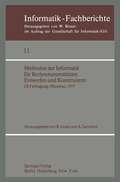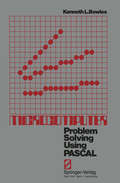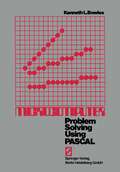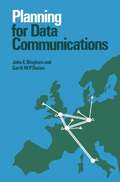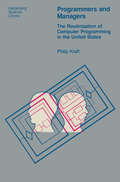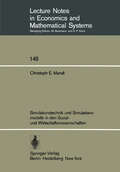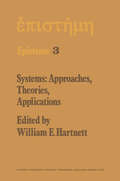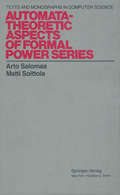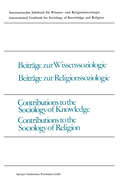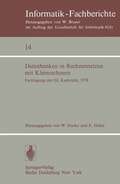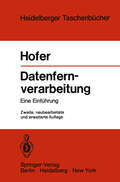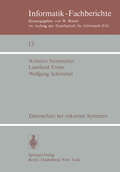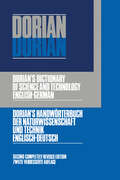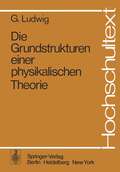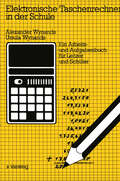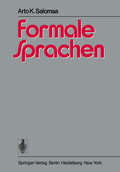- Table View
- List View
Methoden der Informatik für Rechnerunterstütztes Entwerfen und Konstruieren: GI-Fachtagung, München, 19.–21. Oktober 1977 (Informatik-Fachberichte #11)
by R. Gnatz K. SamelsonMicrocomputer: Problem Solving Using Pascal (Springer Study Edition)
by K. L. BowlesThis book is designed both for introductory courses in computer problem solving, at the freshman and sophomore college level, and for individual self study. An earlier version of the book has been used seven times for teaching large introductory classes at University of California San Diego (UCSD). This preface is intended for the instructor, or for anyone sophisticated enough in contemporary computing practice to be able to advise the prospective student. The amount of material presented has been completed by about 55 percent of all students taking the course, where UCSD schedules 10 weeks of classes in a quarter. We have taught the course using Keller's Personalized System of Instruction (PSI), though the organization of the book does not require that plan to be used. PSI methods allow slightly more material to be absorbed by the students than is the case with the traditional lecture/recitation presentation. PSI allows grading according to the number of chapter units completed. Virtually all students who pass the course at UCSD do complete the first ten essential chapters and the Exercises associated with them. For a conventional presentation under the semester system, the 15 chapters should present an appropriate amount of material. For a conventional course under the quarter system, one might not expect to complete more than the first 12 chapters except on an extra credit basis.
Modelle für Rechensysteme: Workshop der GI, Bonn, 31. 3.-1. 4. 1977 (Informatik-Fachberichte #9)
by P. P. SpiesPeripheral Nerve Block: Pharmacologic — By Local Anesthesia Electric — By Transdermal Stimulation
by F.L. JenknerFifty years ago surgeons often performed various operations in conduction anesthesia or local anesthesia in the hope of circumventing pulmonary complications. The prepa ration for the operation was the task of an assistant who had to know and carry out the diverse local anesthetic procedures and who was responsible for their effective ness. In this way a large number of physicians learned to carry out nerve blocks, which they also applied more and more outside their operative duties. The introduction of modern general anesthesia led almost to the disappearance of the special techniques of nerve blocking at the former "classic" places of their teaching. Therefore it is a great merit of my former associate F. L. Jenkner to recall the art of nerve blocking, be it for diagnostic or therapeutic purposes. He presents the many possibilities as an addition to the therapeutic armamentarium and explains their indi cations, bases, and techniques. I do not think that one needs to be a specialist to carry out these useful techniques; but one has to have an understanding of certain topographic-anatomic situations, and one needs to know the rules of the procedure to obviate the risks that are always inherent in any disruption of the integrity of the integument of the human body. Thus by presenting all the mentioned aspects a renaissance of good though old practices may be initiated in the light of new achievements.
Programmers and Managers: The Routinization of Computer Programming in the United States (Heidelberg Science Library)
by P. KraftNorbert Wiener, perhaps better than anyone else, understood the intimate and delicate relationship between control and communication: that messages intended as commands do not necessarily differ from those intended simply as facts. Wiener noted the paradox when the modem computer was hardly more than a laboratory curiosity. Thirty years later, the same paradox is at the heart of a severe identity crisis which con fronts computer programmers. Are they primarily members of "management" acting as foremen, whose task it is to ensure that orders emanating from executive suites are faithfully trans lated into comprehensible messages? Or are they perhaps sim ply engineers preoccupied with the technical difficulties of relating "software" to "hardware" and vice versa? Are they aware, furthermore, of the degree to which their work whether as manager or engineer-routinizes the work of others and thereby helps shape the structure of social class relation ships? I doubt that many of us who lived through the first heady and frantic years of software development-at places like the RAND and System Development Corporations-ever took time to think about such questions. The science fiction-like setting of mysterious machines, blinking lights, and torrents of numbers served to awe outsiders who could only marvel at the complexity of it all. We were insiders who constituted a secret society into which only initiates were welcome. So today I marvel at the boundless audacity of a rank out sider in writing a book like Programmers and Managers.
Simulationstechnik und Simulationsmodelle in den Sozial- und Wirtschaftswissenschaften (Lecture Notes in Economics and Mathematical Systems #148)
by C.E. MandlSystems: Including the Proceedings of the Eighth George Hudson Symposium Held at Plattsburgh, New York, April 11–12, 1975 (Episteme #3)
by William E. HartnettFor many years I have believed in a particular style of education for myself. The idea is to focus on matters that you want to learn about, find a modest amount of money, and then organize a symposium of those matters, inviting knowledgeable individuals to participate - and, by extension - to come and help with my education. The Eighth George Hudson Symposium held at Plattsburgh, New York on April 11-12, 1975 was another attempt on my part to learn something. The ostensible reason for the Symposium was explained in the Announce ment of the Symposium as follows: Systems Theory is currently one of the exciting areas of intellectual activity, attracting persons from diverse disciplines. In fact, it has almost become the prototype of inter disciplinary effort. As such, it needs the interchange of ideas, viewpoints, and opinions as a necessary condition for growth. This Symposium was convened to bring together a number of persons- some of them experts and some beginners - for two days of con centrated interaction on Systems Theory. The breadth of the interests of the invited speakers can be noted from their "home" disciplines but space limitations forestall any attempt to document their actual current interests which range from brain function to political institutions to technoethics. The speakers were chosen for their expository and interactive ability as well as for their work in Systems Theory and ample time has been allowed for discussion with them.
Automata-Theoretic Aspects of Formal Power Series (Monographs in Computer Science)
by Arto Salomaa Matti SoittolaThis book develops a theory of formal power series in noncommuting variables, the main emphasis being on results applicable to automata and formal language theory. This theory was initiated around 196O-apart from some scattered work done earlier in connection with free groups-by M. P. Schutzenberger to whom also belong some of the main results. So far there is no book in existence concerning this theory. This lack has had the unfortunate effect that formal power series have not been known and used by theoretical computer scientists to the extent they in our estimation should have been. As with most mathematical formalisms, the formalism of power series is capable of unifying and generalizing known results. However, it is also capable of establishing specific results which are difficult if not impossible to establish by other means. This is a point we hope to be able to make in this book. That formal power series constitute a powerful tool in automata and language theory depends on the fact that they in a sense lead to the arithmetization of automata and language theory. We invite the reader to prove, for instance, Theorem IV. 5. 3 or Corollaries III. 7. 8 and III. 7.- all specific results in language theory-by some other means. Although this book is mostly self-contained, the reader is assumed to have some background in algebra and analysis, as well as in automata and formal language theory.
Automated Theorem Proving: A Logical Basis (Fundamental Studies in Computer Science #1)
by D.W. LovelandAutomated Theorem Proving: A Logical Basis
Beiträge zur Wissenssoziologie, Beiträge zur Religionssoziologie / Contributions to the Sociology of Knowledge, Contributions to the Sociology of Religion (Internationales Jahrbuch für Wissens- und Religionssoziologie/International yearbook for sociology of knowledge and religion #11)
by Vojin MilićBildverarbeitung und Mustererkennung: DAGM Symposium, Oberpfaffenhofen 11.–13. Oktober 1978 (Informatik-Fachberichte #17)
by E. TriendlDie Arbeiten zu Bildverarbeitung und Mustererkennung sind ein Versuch, die Natur der Wahrnehmung zu begreifen und die menschliche Intelligenzleistung in einern schmalen Teilbereich zu unterstützen. Überdies trägt die zunehmende Verfügbarkeit von Rechenanlagen zu den weltweiten Bemühungen um Fortschritte auf diesem Gebiet bei. Neue Aspekte und Ergebnisse zeigen sich in so kurzen Abständen und in solcher Fülle, daß ein Überblick über das Gesarntgebiet der Muster erkennung in jährlicher Folge nützlich erscheint. Der vorliegende Tagungsband zeigt einen repräsentativen Querschnitt durch den Stand der Arbeiten in der Bundesrepublik im Sommer 1978. Das Symposium wird von der Deutschen Arbeitsgemeinschaft für Mustererkennung (DAGM) organisiert und von der Deutschen Forschungs und Versuchsanstalt für Luft- und Raumfahrt (DFVLR) ausgerichtet. Die DAGM ist ein Dachverband folgender wissenschaftlicher Gesellschaften: Deutsche Gesellschaft für angewandte Optik (DGaO), Deutsche Gesellschaft für Ortung und Navigation (DGON), Deutsche Gesellschaft für Medizinische Dokumentation, Information und Statistik (GMDS), Deutsche Gesellschaft für Angewandte Datenverarbeitung und Automation in der Medizin (GADAM), Gesellschaft für Informatik (GI), Nachrichtentechnische Gesellschaft (NTG). Die DAGM fördert den Erfahrungsaustausch auf dem Gesarntgebiet der Mustererkennung und ist als Nationales Komitee Mitglied der Inter national AS,sociation for Pattern Recogni ti on (IAPR). Für die Arbeit im Programm-Ausschuß möchte ich mich bedanken bei J.P. Foith, Karlsruhe; Prof. H. Niemann, Erlangen; Prof. E. Paulus, Braunschweig; Prof. G. Winkler, Karlsruhe. An der Organisation haben mitgewirkt J.P. FOith, Institut für Informa tionsverarbeitung in Technik und Biologie, Karlsruhe und H. Platzer, Lehrstuhl für Nachrichtentechnik der TU München, sowie das Institut für Nachrichtentechnik der DFVLR Oberpfaffenhofen.
Coding Theorems of Information Theory (Ergebnisse der Mathematik und ihrer Grenzgebiete. 2. Folge #31)
by J. WolfowitzThe objective of the present edition of this monograph is the same as that of earlier editions, namely, to provide readers with some mathemati cal maturity a rigorous and modern introduction to the ideas and principal theorems of probabilistic information theory. It is not necessary that readers have any prior knowledge whatever of information theory. The rapid development of the subject has had the consequence that any one book can now cover only a fraction of the literature. The latter is often written by engineers for engineers, and the mathematical reader may have some difficulty with it. The mathematician who understands the content and methods of this monograph should be able to read the literature and start on research of his own in a subject of mathematical beauty and interest. The present edition differs from the second in the following: Chapter 6 has been completely replaced by one on arbitrarily varying channels. Chapter 7 has been greatly enlarged. Chapter 8 on semi-continuous channels has been drastically shortened, and Chapter 11 on sequential decoding completely removed. The new Chapters 11-15 consist entirely of material which has been developed only in the last few years. The topics discussed are rate distortion, source coding, multiple access channels, and degraded broadcast channels. Even the specialist will find a new approach in the treatment of these subjects. Many of the proofs are new, more perspicuous, and considerably shorter than the original ones.
Datenbanken in Rechnernetzen mit Kleinrechnern: GI-Fachtagung mit Unterstützung durch das German Chapter der ACM, 11./12. April 1978, Kernforschungszentrum Karlsruhe (Informatik-Fachberichte #14)
by W. Stucky E. HollerDatenfernverarbeitung: Außenstelle — Datenfernübertragung Rechenzentrum — Betriebsabwicklung Eine Einführung (Heidelberger Taschenbücher #120)
by H. HoferDatenschutz bei riskanten Systemen: Eine Konzeption entwickelt am Beispiel eines medizinischen Informationssystems (Informatik-Fachberichte #13)
by W. Steinmüller L. Ermer W. SchimmelThe Design of Well-Structured and Correct Programs (Monographs in Computer Science)
by Suad Alagic Michael A. ArbibThe major goal of this book is to present the techniques of top-down program design and verification of program correctness hand-in-hand. It thus aims to give readers a new way of looking at algorithms and their design, synthesizing ten years of research in the process. It provides many examples of program and proof development with the aid of a formal and informal treatment of Hoare's method of invariants. Modem widely accepted control structures and data structures are explained in detail, together with their formal definitions, as a basis for their use in the design of correct algorithms. We provide and apply proof rules for a wide range of program structures, including conditionals, loops, procedures and recur sion. We analyze situations in which the restricted use of gotos can be justified, providing a new approach to proof rules for such situations. We study several important techniques of data structuring, including arrays, files, records and linked structures. The secondary goal of this book is to teach the reader how to use the programming language Pascal. This is the first text to teach Pascal pro gramming in a fashion which not only includes advanced algorithms which operate on advanced data structures, but also provides the full axiomatic definition of Pascal due to Wirth and Hoare. Our approach to the language is very different from that of a conventional programming text.
Dictionary of Science and Technology: English-German
by UNKNOWN AUTHORDorian's Dictionary of Science and Technology: English-German, Second Revised Edition focuses on the compilation of terms employed in science and technology. The book first takes a look at abduction, aberration, abhesion, abating, ablation, abscission, coupling, covering, back iron, cross-breeding, clip, cleats, channel, circuit diagram, connection, conveyors, and supercharger. The manuscript then takes a look at dabbing, dacite, dactyl, daffodil, damp, earmark, earphone, ripening, current prospecting, facilities, gaff, gablet, galaxy, gale, gait, gall, and galipot. The publication ponders on haddock, Hadley quadrant, H-bomb, habitation, habituation, hemoglobin, hailstorm, hail, halation, ichnography, iceboat, oblate, oblique, electrode structure, obesity, oatmeal, dyeing, and pachyderm. The text then explores wainscoting, waist, wale, waiver, ultrafilter, ultrahigh frequency, ulocarcinoma, elongation, vaccinal fever, vaccination, vaccine, vacancy, and vacuometer. The text is a dependable source of data for researchers interested in the terms used in science and technology.
